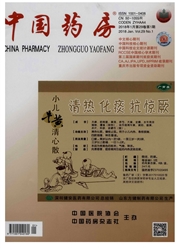

 中文摘要:
中文摘要:
目的:研究双藤巴布剂中青藤碱、雷公藤甲素的体外释放与体外透皮机制;比较以化学单体入药(青藤碱雷公藤甲素巴布剂,STP)与浸膏入药(双藤巴布剂,STEP)释放速率与透皮速率的差异。方法:通过释放度测定法测定体外释放度;通过Franze扩散池法测定药物的体外透皮性,皮肤为裸鼠背部皮肤。结果:STP与STEP中青藤碱、雷公藤甲素的体外释放以Higuchi方程拟合度较优(STP:r青=0.9955,r甲=0.9958;STEP:r青=0.9920,r甲=0.9963)。经皮渗透较好地拟合了零级动力学方程,青藤碱在STP、STEP中的r分别为0.9951与0.9926,透皮速率分别为21.729μg·cm^2·h^-1与20.063μg·cm^2·h^-1;雷公藤甲素在STP、STEP中的,分别为0.9942与0.9902,透皮速率分别为0.4783μg·cm^2·h^-1与0.4168μg·cm^2·h^-1。结论:青藤碱、雷公藤甲素在STP、STEP中的释放速率大于其经皮渗透速率,属于皮肤限速型经皮给药制剂。
 英文摘要:
英文摘要:
OBJECTIVE: To study in vitro release and transdermal mechanism of sinomenine and triptolide in Shuangteng cataplasm, and to compare the release rate and transdermal velocity of chemical components as potion ingredients (sinomenine and triptolide cataplasm, STP) and extractum as potion ingredients (cataplasm of extracts from caulis sinomenii and tripterygium wilfordii, STEP). METHODS: In vitro release rate was determined by release rate detection; in vitro transdermal property of drugs was detected by Franze diffusion cell, and skin of nude mice back was used for test. RESULTS: In vitro drug release of sinomenine and triptolide in STP and STEP were in line with Higuchi equation (STP : rssinomenine = 0.995 5, rssinomenine = 0.995 8 ; STEP : rrssinomenine = 0.992 0, rssinomenind=0.996 3).The transdermal process was in accordance with zero-level equation (STP:rsinomenine=0.995 1, rtriptalid=0.994 2;STEP: rsincmenine=0.992 6,rtriptolid=0.990 2). The transdermal velocity constants were 21.729 μg.cm^-2.h^-1 and 0.478 3 μg.cm^-2.h ^-1,20.063 μg·cm ^-2·h^-1 and 0.416 8 μg.cm^-2.h^-1 respectively. CONCLUSION: Release rate of sinomenine and triptolide in STP or STEP in vitro is higher than transdermal velocity of them, and they are transderm delivery preparation correlated to skin permeation.
 同期刊论文项目
同期刊论文项目
 同项目期刊论文
同项目期刊论文
 期刊信息
期刊信息
